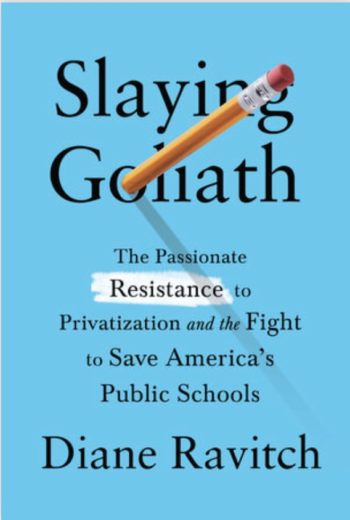John Thompson: Diane Ravitch’s Slaying Goliath Documents Decades of Disruption
By John Thompson.
Part Two of two.
Diane Ravitch’s Slaying Goliath: The Passionate Resistance to Privatization and the Fight to Save America’s Public Schools is the history of the rise and fall of test-driven, competition-driven school reform. As in her two previous, ground-breaking books, Ravitch changes the terms of debate over public education. She previously reframed the battle over the “Billionaires Boys Club” which drove “corporate reform,” and “privatization.” Ravitch now characterizes data-driven, choice driven reformers as “Disrupters,” and the grassroots anti-“Goliath” movement as the “Resisters.” She also tells the stories of that social movement, contrasting it with the faux-movement funded by the Disrupters.
The debacles produced by the Disrupters resulted from high-stakes testing, combined with competition with charters (and vouchers), as well as the hurried, untested, manner that they imposed value-added teacher evaluations; mass closures of schools; Common Core standards; behaviorist methods i.e. “No Excuses;” digital technology known as “personalized learning;” and expensive public relations campaigns that demonized teachers.
This second post will focus on Ravitch’s analysis of the research which predicted the defeat of accountability-driven, charter-driven policies. Perhaps the most striking pattern documented in Slaying Goliath is how they failed in the way that scholars and practitioners anticipated.
 Decades of Disruption-driven reform began with the false claim “that American education was failing and the only way to fix it was with standards, tests, competition, and accountability.” As Arne Duncan’s public relations officer and Walton-funded reformer Peter Cunningham said, “We measure what we treasure.”
Decades of Disruption-driven reform began with the false claim “that American education was failing and the only way to fix it was with standards, tests, competition, and accountability.” As Arne Duncan’s public relations officer and Walton-funded reformer Peter Cunningham said, “We measure what we treasure.”
Ravitch’s response was, “I was taken aback because I could not imagine how to measure what I treasure: my family, my friends, my pets, my colleagues, my work, the art and books I have collected.” And that foreshadows the victory of the Resistance over Goliath. Most educators, patrons, and students agree that children are more than a test score.
No Child Left Behind and the Race to the Top set impossible test score targets. They were based in large part on the weird idea that “no-excuses” behaviorist pedagogies could be quickly “scaled up,” providing poor children of color a ladder to economic equality. Drawing on the tradition of Edward Thorndike and B.F. Skinner, reformers “rigidly prescribed conditioning via punishments and rewards.” Previewing their fatal flaw, Ravitch observes, CONTINUE READING: John Thompson: Diane Ravitch's Slaying Goliath Documents Decades of Disruption - Living in Dialogue



